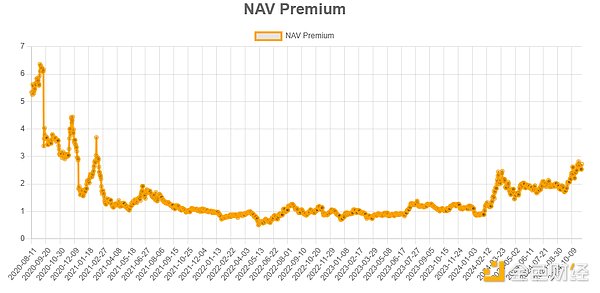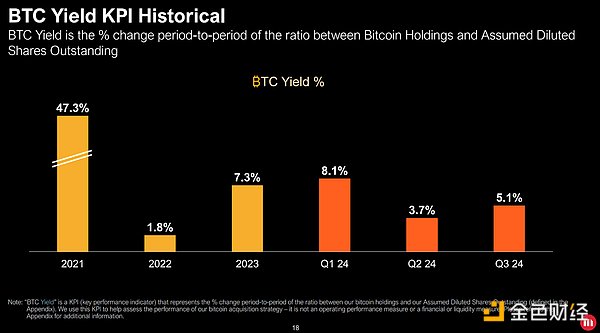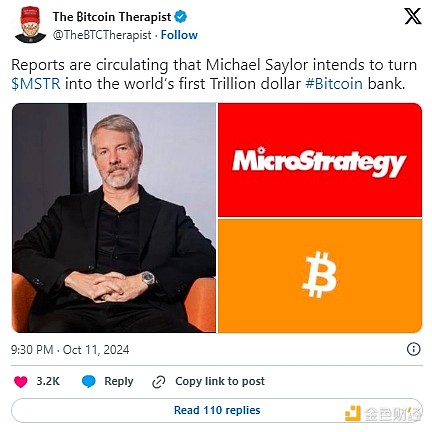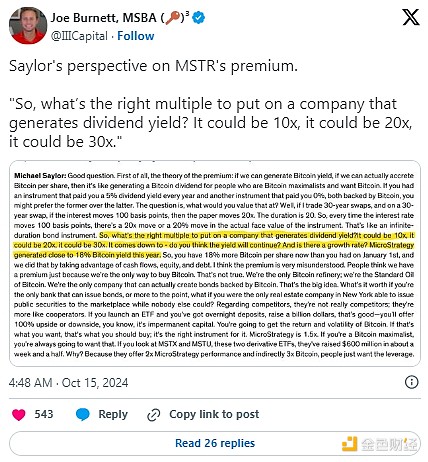Author: Jack Inabinet, Bankless; Translated by Bai Shui, Jinse Finance
Michael Saylor's MicroStrategy (MSTR) has been accumulating BTC since 2020, and it has become unstoppable, transforming the software company into one of the best-performing equity investments in the past two bull market cycles.
Although MSTR will see massive losses every quarter in 2024, its performance still easily surpasses BTC, with its price doubling in a parabolic fashion since September, and up 200% so far this year!
At MicroStrategy's latest earnings call on October 30, the company's executives unveiled their "21/21 Plan", a strategic initiative aimed at raising $42 billion in capital (equivalent to 80% of MSTR's market cap at the time of analysis) in a 50/50 split. The planned combination of stock sales and bond issuances is set to become the largest secondary equity offering in US stock market history.
Today, we'll unpack Michael Saylor's infinite money machine and explore how MicroStrategy plans to become a trillion-dollar company.
What is Saylor Creating?
MicroStrategy announced in August 2020 that it had invested $250 million to purchase 21,454 BTC, becoming the first publicly traded company to implement a BTC treasury strategy, with this initial investment returning nearly 500% over its 4-year lifespan.
As of September 2024, MicroStrategy holds 252,220 bitcoins.
While MicroStrategy has maintained its status as a BTC heavyweight among direct corporate holders, the launch of the spot BTC ETF in January 2024 has reshaped the landscape of the largest holders, with BlackRock replacing MicroStrategy as the fourth-largest BTC entity, behind Binance, Coinbase, and Kraken.
Although the market initially valued MicroStrategy at five times the value of its BTC assets, as holders gradually realized that they would be perpetually diluted to fund additional BTC purchases, and with the bear market malaise by the end of 2021, this premium began to disappear, and MSTR found itself trading below its net asset value (NAV).

Unlike in 2020 when MicroStrategy first started accumulating BTC, investors no longer need to exit traditional markets to gain crypto asset exposure, but even in the ETF era, MSTR stock has continued to trade at a persistent premium since February 2024.
Compared to simple BTC performance tracking (minus management fees) spot ETFs, MicroStrategy provides its shareholders with a BTC accumulation strategy tool that can increase the token count per share.
When the trading price of MSTR stock is higher than the BTC it holds, MicroStrategy can conveniently raise funds through two avenues: at-the-market equity offerings and convertible bond sales. The authorization for at-the-market equity offerings allows MicroStrategy to issue and sell new MSTR shares to the market to raise cash, while convertible bond sales enable MicroStrategy to borrow money on extremely favorable terms in exchange for redeemable debt obligations or a certain number of MSTR shares in the future.
In its Q2 2024 earnings report, Microstrategy introduced "BTC yield" as a key investor performance metric, emphasizing the quarter-over-quarter growth in BTC holdings per share.

Although MicroStrategy unconventionally obtained a $205 million BTC-collateralized term loan from Silvergate in March 2022 amid the bear market, crypto industry experts often liken the company to a money printing machine, as its executives seem to raise unlimited cash during market booms to purchase BTC through stock dilution.
In a recent interview with sell-side research firm Bernstein analysts, Michael Saylor revealed his company's ultimate goal: to transform into a mature Bitcoin financial services provider.
When shareholders buy MSTR, they are not only purchasing BTC, but also the ability of the management team to effectively utilize the capital markets and balance sheet to generate greater returns.

Investment Considerations
MSTR has undoubtedly outperformed BTC in 2024, but historically, it has also exhibited higher volatility, experiencing more severe downward swings alongside its substantial upward rebounds. Speculators seeking leveraged BTC exposure would be better off directly utilizing the underlying asset.
While the savvy use of public capital markets allows MSTR shareholders to accumulate more BTC, Microstrategy's ability depends on the willingness of investors to continue buying the stock at a premium.
As shown in 2022, MSTR stock may trade at a discount to net asset value for an extended period. If convertible bonds mature while the asset value remains discounted, Microstrategy will be forced to sell an unexpectedly large number of shares to dilute investors' equity, or sell its BTC holdings to redeem the outstanding debt.
The FASB rule change set to be implemented this December will allow digital assets to be reported at their fair market value. Although Microstrategy has reported consecutive quarterly net losses in 2024, the adoption of these new accounting standards will have a positive impact on the company's financials, making MSTR a potential candidate for inclusion in the S&P 500 index. Adding it to indices like the S&P 500 or Nasdaq 100 would unleash passive, indiscriminate price flows that could be sold to accumulate more BTC!
Compared to investing in non-productive spot BTC, MicroStrategy stock has the ability to accumulate additional tokens, and unlike companies in the highly competitive cryptocurrency mining space, Microstrategy enjoys a significant differentiation advantage due to its massive BTC moat. As long as there is a desire to speculate on BTC, investors can rest assured that there will likely be someone willing to buy the stock at a premium or lend cash on favorable terms.






